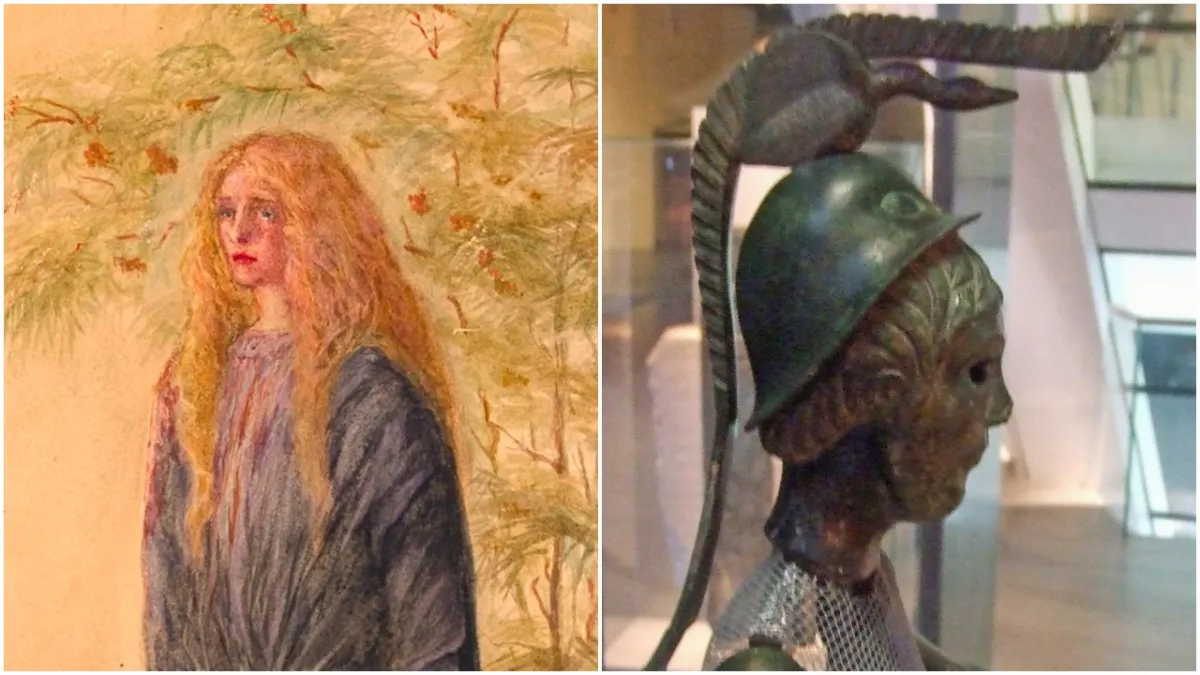Happy Imbolc! That term may be unfamiliar to you if you don’t spend much time around pagans, but the ancient Irish precursor to Groundhog Day marks the midpoint (give or take) between the winter solstice and the spring equinox. For some, it marks the beginning of spring, or at least the day when sping once again begins to feel like a solid possibility and not a distant dream. But it’s also a sacred day to a powerful and versatile Goddess who deserves her own due and deep dive: Brigid.
Whole books have been written about Brigid (I love this one by Courtney Webber or this one by Morgan Daimler), so we’ll be talking very broad terms here. If I miss something, please know it’s a factor of space and time, and I’m always excited to learn more. And that’s because there is so much to Brigid. She is a goddess of many faces and many names. Sometimes quite literally.
She is called Brigantia, Brid, Bride, Briginda, Brigdu, and Brigit, meaning “the exalted one” in her form as a Goddess. She is known as an Irish Goddess and is closely tied to that land, but her origin, though mysterious, is Celtic which makes it complicated.
The Celts’ territory covered much of Europe in the centuries up to the birth of Christ. Celtic settlements and influence have been found in Germany, Gaul (now France), Spain, and more. They clashed many times with the Romans and the last vestiges of the culture, where it has survived the most, were driven to the edges of the Empire: The British Isle. The Goddess Brigantia from whose name “Britania” is derived may have been Brigid herself or a version of her. The Romans equated her with their Goddess of wisdom and war, Minerva, but Brigid is more than just that.
Though she is a goddess of inspiration, fire, poetry, and spring, Brigid, like other Irish deities, was many things, and perhaps even many goddesses in one. Many refer to her as a triple goddess, which is accurate, but I want to be clear that the triple goddess of modern paganism—the Maiden, Mother, and Crone—is a modern expression of old archetypes, and Brigid triple nature was not a maiden-mother-crone trinity.
Brigid is a goddess of inspiration, but she is also a goddess of fire and smithcraft, and also a goddess of healing and sacred wells, and also a protector of the home and hearth. She’s adaptable and powerful, which may be why she, perhaps more than any other pagan deity, has evolved and persisted over the millennia. Like a sword reforged for a new purpose, in order to protect her people and serve her purpose of inspiration and light, Brigid has changed with the times.
St. Brigid of Kildare is both a goddess in disguise and her own distinct being … maybe. She shares a name with the goddess, and there’s a debate about whether she was a real person or just made up so that after Christianity came to Ireland, worship of Brigid could continue. Around the fifth century CE, This saint emerges as an abbess in Ireland whose magic and miracles are all very much like that of the Goddess Brigid. And of course, her feast day is Brigid’s day: Imbolc, which was Christianized as Candlemas.
St. Brigid is a protector of the home, fires, cattle, wells, smiths, and more. And her followers kept her flame. Though we’re not certain, archeologists theorize that priestesses of Brigid kept an eternal flame at her temple in what is now Kildare, Ireland. The temple became an abbey and the nuns there took over keeping Brigid’s flame for another thousand years. It was eventually destroyed for being too pagan, which sounds accurate.
As a nun and Saint, Brigid also became, much later, a hidden icon for the gay community. Brigid of Kildare shared her life with another nun, the story goes, named Darlughdach, who was essentially her soul mate. It was a very Xena and Gabrielle situation. They slept in the same bed, they lived and worked together, and one time when Brigid caught Darlughdach looking at a male warrior and made Darlughdach walk with hot coals in her shoes as penance. Obviously, we can’t impose modern ideas of sexuality on a saint who may or may not have been a real person but … Harold, they’re lesbians.
Also, the name Darlughdach, means “daughter of Lugh.” Lugh is another many-skilled Irish god whose chief festival, Lughnasadh, is opposite Brigid’s on the Wheel of the year, on August 1. There’s clearly a connection here, and the vagueness and malleability of it, like a changing flame, allows Brigid to be many things as she is needed.
That Brigid has become a patron of the LGBT community as well as the Irish diaspora as they have struggled, speaks to how Brigid has been embraced by marginalized communities. That’s even clearer in her role in the new world. Indentured Irish servants working alongside African slaves in the eighteenth and nineteenth centuries, as well as Irish immigrants mixing with the other cultures of places like New Orleans, meant the Brigid found her way into the religion of Voodoo (or VouDou in Haiti). There her name became Maman Brigitte.
Mamam Brigitte is a loa or lwa, a deity or spirit associated with Haitian Vodou or New Orleans Voodoo. Maman Brigitte is very different from Brigid. She is a spirit of cemeteries and death, and the consort of Baron Samedi. The first woman buried in a cemetery is called “the Brigitte.” According to Courtney Webber, she is “a tough character, often described as a profanity-spewing, hardened presence, but full of fierce love.” She is also the only Loa who is white, with, like most versions of Brigid, distinct red hair.
Brigid and Maman Brigitte, and indeed, Brigid of Kildare are not all “the same.” They are descendants and evolutions, like new fires lit from a central flame. From just these few tales, it’s clear the Brigid is variable, adaptable, powerful, and inspiring. And for many pagan, Catholics, and others who celebrate her, she still is. So, light a candle for Brigid tonight if you feel like it, and take a spark of inspiration.
(Images: Wikimedia Commons)
Want more stories like this? Become a subscriber and support the site!
—The Mary Sue has a strict comment policy that forbids, but is not limited to, personal insults toward anyone, hate speech, and trolling.—









